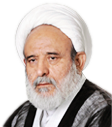The Birth of F¡§imah
Sh¢`ite historians unanimously contend that Lady F¡§imah was born in Mecca in the fifth year after Hegira.[1] The youngest child of the Holy Prophet and Khad¢jah, F¡§imah (¥) married Imam `Al¢ (a.s) in Medina after the Holy Prophet's Hegira. During her early age, she witnessed her father's severest struggles against the unbelievers; she could vividly remember all the troubles of that period.
The Night Ascension (Mi`r¡j)
The Holy Prophet's nocturnal journey from Mecca to Jerusalem (isr¡' [Qur'¡n 17:1]) in a supernatural way and his journey from Jerusalem to the Heavens (mi`r¡j [Qur'¡n: 70]) through God's power are both significant events of Mecca, because these two events are recorded in the Meccan s£rahs; however, there are disagreements related to the exact date of their occurrence.
The Holy Prophet's objectives of these two journeys was to closely observe God's Grandeur across the heavens and skies, to meet the angels and the souls of the previous prophets, to watch Paradise and Hell and to observe the differing ranks of the dwellers of Paradise and the residents of Hell. God refers to this journey as follows:
Glory be to Him who made His servant to go on a night from the Sacred Mosque to the Remote Mosque of which We have blessed the precincts, so that We may show to him some of Our Signs; Surely, He is the Hearing, the Seeing. (17:1)
Concerning mi`r¡j, God remarks:
Certainly, he saw of the greatest signs of his Lord. (53:18)
Imam al-Ri¤¡ (¥) was asked, “Why did God take the Prophet to the skies when He has no definite place?” Imam al-Ri¤¡ (¥) replied, “God would not need any place or time. By taking the Holy Prophet to the skies, God intended to glorify the angels and the sky-dwellers. God also wanted Mu¦ammad (¥) to observe the extension of the creation so that upon his descent he could inform people of God's Grandeur. God does not need time or place as the skeptics erroneously assume.”[2]
The Evaluation of the Narrations on mi`r¡j
Concerning the Holy Prophet's Divine journey, there are several narrations available. However, ±abirs¢, a well-known exegete of the Holy Qur'¡n, has divided these narrations into four headings:
(1) Uninterruptedly reported narrations (mutaw¡tir); they are definite and certain; one of these is the principle of mi`r¡j.
(2) Narrations reporting issues that are logically and rationally accepted and are not in opposition with any known principle; such as those reporting the Holy Prophet's travel in the skies for the purpose of visiting Paradise and Hell.
(3) Narrations that are superficially in conflict with the absolute principles derived from the verses of the Holy Qur'¡n and Islamic traditions, but are interpretable anyway. Such narrations should be interpreted in such a way that they could be in harmony with correct beliefs. An example is the content of the traditions reporting the Holy Prophet’s meeting with a group of people in Paradise and another group in Hell. These scenes are a kind of allegory for us to visualize Paradise and Hell.
(4) Materials that are superficially unacceptable and not interpretable, such as the report that the Holy Prophet saw God with his own eyes, talked to Him and sat on His Throne next to Him. Such issues are null and void.[3]
In the opinion of the Twelvers Im¡miyyah, the Holy Prophet's heavenly journey was material; i.e. he made this ascension in body and soul.[4] According to Islamic narrations, during the mi`r¡j, the daily and nightly prayers were set at five.[5] If, prior to mi`r¡j, some prayers are observed being performed by either the Holy Prophet or Imam `Al¢, it has been either a non-compulsory prayer or a kind of prayer based on the specific situations which was not a regular daily prayer with which we are familiar.[6]
[1] al-Majlis¢, Bi¦¡r al-Anw¡r 43:7.
The majority of Sunni scholars believe that Lady F¡§imah was born five years after prophethood. See Sayyid Ja`far Shah¢di, Life of F¡§imah.
[2] Tafs¢r al-Burh¡n 2:400.
[3] Majma` al-Bay¡n 6:395.
[4] al-Majlis¢, op cit,; 18, pp. 290; Tafs¢r Nem£neh 12:17. A physics-based explanation of the Night Ascension can be seen in Tafs¢r Nem£neh 12:17-20 and Fur£gh Abadiyyat 2:393.
[5] Shaykh al-Kulayn¢, al-Fur£` min al-K¡f¢ 3:482-487; Ibn Sa`d, al-±abaq¡t al-Kubr¡ 1:213; ¯a¦¢¦ al-Bukh¡r¢; al-°urr al-`ªmil¢, Was¡'il al-Sh¢`ah 3:76; al-Majlis¢, op cit, 18:238; Tafs¢r al-Burh¡n 2:933.
[6] All¡mah Am¢n¢, al-Ghad¢r 3:242.













